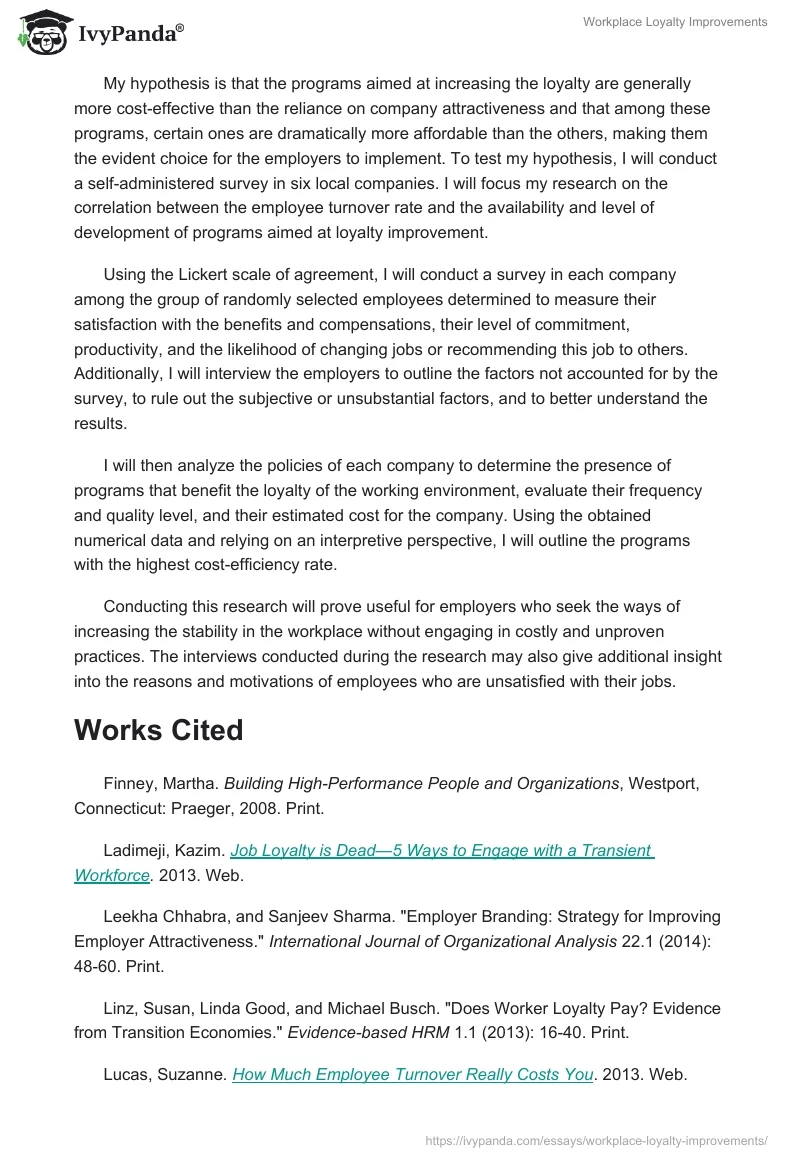Loyalty is among the key components of a successful business. Not only does it secure the stability of the company, but it also contributes considerably to the bottom-line profits. ISR Global Research Director Patrick Kulesa points at the direct relationship between employee engagement, commitment, motivation, recognition of company values, and the business results while pointing out the crucial role of loyalty in all of the mentioned factors (Finney 193).
Besides, some researchers point to the fact that it can benefit the employee in many ways (Linz, Good, and Busch 37). At the same time, there is a strong tendency of declining loyalty as more employees effortlessly change workplaces either in search of better conditions or because of dissatisfaction with the current situation. In fact, as much as 69 percent of employees are not only in active search of a job but deem it their “daily routine” (Ladimeji par. 1).
The generation of millennials shows even more alarming results, with 91 percent of the respondents saying they are anticipating to stay at their jobs for no more than three years while the actual average duration of employment is 4.4 years (Meister par. 1). Besides the logical assumption that such tendencies compromise stability, major financial drawbacks also factor in. While the exact numbers vary, the estimates show that replacing a lost employee costs as high as 150 of the annual employee salary (Lucas par. 4).
With such evident adverse effects, it can be assumed that companies should have strategies for increasing employee loyalty, which, unfortunately, is not always the case. The usual assumption by the management is that if the company is successful enough, the employees are happy to be a part of it. Meanwhile, studies show that brand recognition, despite being among the chief factors, is not sufficient to guarantee the loyal worker (Leekha and Sharma 58). Other factors, like organizational culture, are frequently neglected by the employers despite being cited both by respondents and studies as leading causes of job dissatisfaction. Therefore, it is absolutely crucial to develop new ways of increasing loyalty in the workplace.
My hypothesis is that the programs aimed at increasing the loyalty are generally more cost-effective than the reliance on company attractiveness and that among these programs, certain ones are dramatically more affordable than the others, making them the evident choice for the employers to implement. To test my hypothesis, I will conduct a self-administered survey in six local companies. I will focus my research on the correlation between the employee turnover rate and the availability and level of development of programs aimed at loyalty improvement.
Using the Lickert scale of agreement, I will conduct a survey in each company among the group of randomly selected employees determined to measure their satisfaction with the benefits and compensations, their level of commitment, productivity, and the likelihood of changing jobs or recommending this job to others. Additionally, I will interview the employers to outline the factors not accounted for by the survey, to rule out the subjective or unsubstantial factors, and to better understand the results.
I will then analyze the policies of each company to determine the presence of programs that benefit the loyalty of the working environment, evaluate their frequency and quality level, and their estimated cost for the company. Using the obtained numerical data and relying on an interpretive perspective, I will outline the programs with the highest cost-efficiency rate.
Conducting this research will prove useful for employers who seek the ways of increasing the stability in the workplace without engaging in costly and unproven practices. The interviews conducted during the research may also give additional insight into the reasons and motivations of employees who are unsatisfied with their jobs.
Works Cited
Finney, Martha. Building High-Performance People and Organizations, Westport, Connecticut: Praeger, 2008. Print.
Ladimeji, Kazim. Job Loyalty is Dead—5 Ways to Engage with a Transient Workforce. 2013. Web.
Leekha Chhabra, and Sanjeev Sharma. “Employer Branding: Strategy for Improving Employer Attractiveness.” International Journal of Organizational Analysis 22.1 (2014): 48-60. Print.
Linz, Susan, Linda Good, and Michael Busch. “Does Worker Loyalty Pay? Evidence from Transition Economies.” Evidence-based HRM 1.1 (2013): 16-40. Print.
Lucas, Suzanne. How Much Employee Turnover Really Costs You. 2013. Web.
Meister, Jeanne. Job Hopping is the ‘New Normal’ for Millennials: Three Ways to Prevent a Human Resource Nightmare. 2012. Web.


